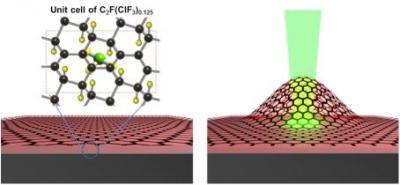Researchers from the National University of Singapore created the world's first nanosized heat engine, made from nanometre-thick fluorinated graphene. Such a tiny engine may be useful in nanorobotics and nanomachines. It can also be used as a valve for microfluids.

The new nano-engine is made of graphene and weakly chemisorbed ClF3 molecules. The CIF3 molecules are used as actuators. The engine uses a laser light beam as the ignition plug - when the CIF3 molecules are exposed to the laser (532 nm wavelength) they sublimate - which expand the volume at the interface between the graphene and the substrate it is grown on. This generates a high pressure (around 23 MPa) and creates a "dome-like blister". The expansion (and later contraction when the laser is turned off) is equivalent to the motion of a piston in an internal combustion engine. The blister size can be controlled by changing the laser power.
The researchers report that this tiny engine is durable and does not degrade even after 10,000 cycles. The estimated internal pressure per expansion cycle of the engine is about 106 Pa. The blister forms very quickly - in less than 0.001 seconds.

